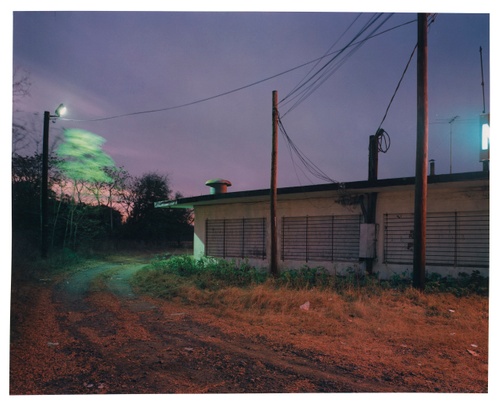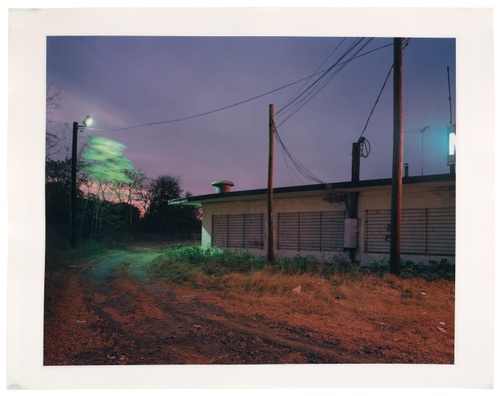



paper size: 16 1/2 x 21 1/8 in.
Inscribed in pencil, verso, lower center: 45/70
Signed in pencil, verso, lower right: Joe Maloney
Ongoing Research
Tang Collective Catalog
Paramus, New Jersey. The grass here is a sickly yellow-orange, and plastic bags rustle in the hot, summer breeze, like animals mucking about in the foliage, though no animals have touched this area for years now. Too polluted, the poison-green streetlight tells us. The light casts down upon a small section of grass and tints the blades a hue reminiscent of chlorophyll. It’s like the grass doesn’t know how to be grass anymore in this foreign landscape.
Back in the 1920s and 30s, there were women working in radium dial factories in New Jersey. They would paint these dials in this substance so that they would glow in the dark for the World War II soldiers that used them. It was painstaking work, and the women needed to be as efficient as possible so that the watches could be sent to the U.S Army. They were taught to put their dirty paint brushes in their mouths to create a fine point for painting. All of these women would end up dying in horrific ways. Their teeth and jaws would rot, along with other bones in their bodies. Later, it was discovered that this element, radium, was radioactive, and these women had been ingesting the substance for months. Some of them had even used the radium as makeup, and often their clothing would glow in the dark after working in the factories. In one scene in the 2000 play Radium Girls, one of these women workers returns home late at night and takes off her work clothes, and as she finally settles herself in bed, she sees her hung-up work clothes glowing faintly in the dark, like a green ghost. Perhaps it’s this ghost that haunts Paramus, the ghost of history.
The sky is a deep, vibrant purple, and nearly cloudless, if not for the sour apple green mass that floats near the streetlamp, hovering over a crop of silhouetted trees. The cloud streaks horizontally, a shapeshifter attempting to imitate the northern lights. The saturated sky and humming street lights scream for attention, and my eyes are drawn like a moth to the flame. It’s as if the photo is a painting, with hues that are almost too vivid to be real. But is it surreal or hyper-real? The exposures have been emphasized in this analog print, but not digitally changed. Is this an unreality, or a heightened reality? The artificial neon glow pulls images of the 80s to mind with its signature color scheme, bringing a strange atmosphere of nostalgia - there’s a sense of longing for a time I’ve never lived through. That reality seems so real, so present to me. It seems that the photograph functions as another ghost, a moment that once existed but has faded into the past, as much as the colorful display tries to convince me otherwise.
I could mention the building that sits on the right side of the foreground, its dirty white panels, the covered-up windows. But there wouldn’t be much to say. The building only holds space as a means of emphasizing the rest of the scene. I don’t want to know about this building, only what lies above it, or behind it. I think of the structure that confines the Chernobyl Nuclear Power Plant. A half-cylinder, on its side, dull white and lifeless. There is no art to its formation, only the significance of its placement. What lies inside its containment — the radioactivity that still remains after the disaster — is the key to its creation. In Paramus, a dirt path carves its way through the orange-yellow grass and is hidden from view by this unmoving, obstructing box that dares to call itself a building. Now I understand what the building adds, by taking up so much of the image. Mystery. I look at this image and I want to know: what could be around the corner? If only I knew what lay outside my perspective of this moment. Maybe I’m not supposed to see beyond my field of vision. There could be unimaginable horrors around the corner, or miracles beyond my comprehension. Or perhaps there is nothing at all. In the case of horrors, my lack of knowledge might just be my savior, but it could also be my downfall.
The fear of not knowing, the fear that comes with not seeing, is a feeling that I am well-acquainted with. In the moments between sleeping and waking, I often imagine creatures lurking in the dark, glowing green eyes following my every movement. I imagine them with such clarity that I almost bring them to life, and I convince myself that I cannot move an inch or I will be discovered by them. The paralysis that comes with this fear is unbearable. And yet, it always seems necessary to protect myself from the sight of my monsters. The structure obscuring the path behind it, as well as the frames of the photograph, acts as a barrier to the unknown, and leaves this knowledge to its obscurity.
Looking at this photograph, one feels as if the image is trying to preserve something, to keep it from slipping away into the past. But what is being preserved? Is it the moment itself, the snapshot of sickly grass and neon light? Is it the ghost of history, the memory of those women who died in the radium factories? Or is it something more ephemeral, something that exists only in the mind of the viewer? For me, this image preserves an aching emotion, a sense of longing for a time and place that I’ve never known, a desire to know what lies beyond the edge of the frame. What horrors — or wonders? — are hiding just out of sight, waiting for me to discover them? The mystery of it all is both thrilling and terrifying. The world is full of unknowns, not just New Jersey. Is the unknown better left unexplored?
In this photograph, with its vibrant hues and its eerie glow, I think of a past that was both haunting and beautiful, a past that is always with us, even as we move forward into the future. I’m struck by the thought that perhaps the ghosts of Paramus aren’t ghosts at all, but rather the echoes of a past that is still very much alive. Why then, is this city so abandoned?
There is a sense of stillness that permeates the scene. The plastic bags that rustle in the breeze, pale ghosts, seem to be the only movement in an otherwise motionless landscape. The summer breeze does nothing to cool the earth, and no humans have inhabited this area for years. The grass remains unaltered, as if it has lost the ability to grow or change. It’s as if time has stopped in this small corner of Paramus, frozen in the past, and in this abandoned place that time has left behind, the scene rots.
Gwendolyn Clark